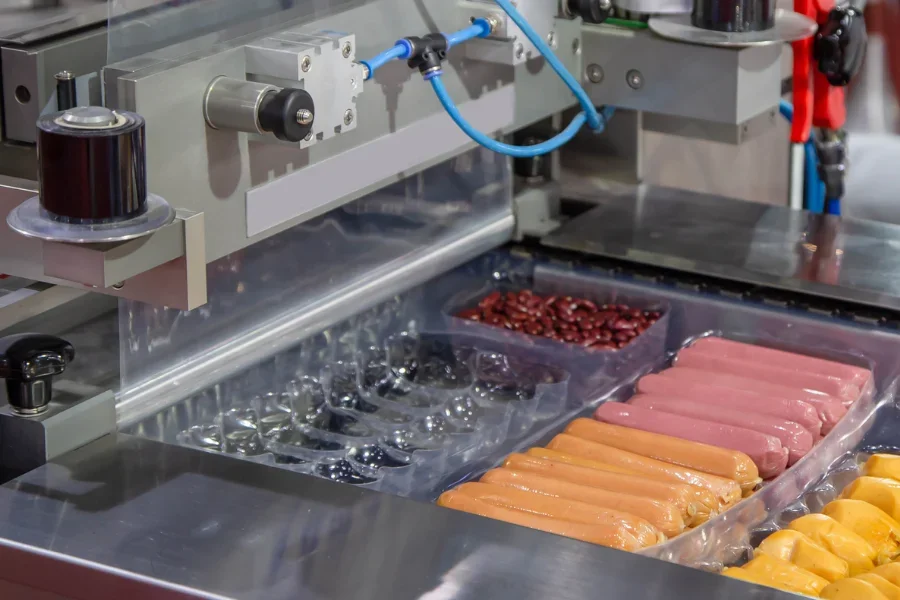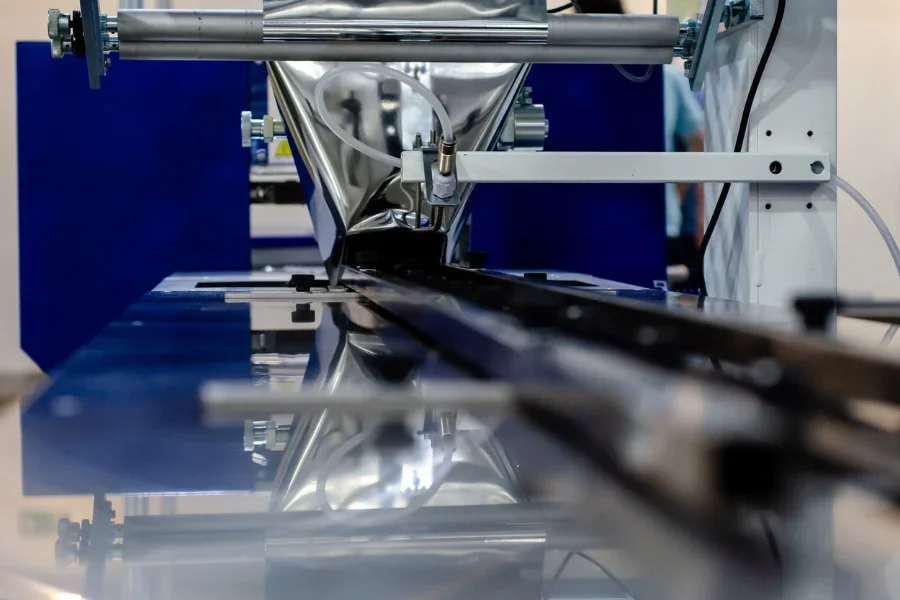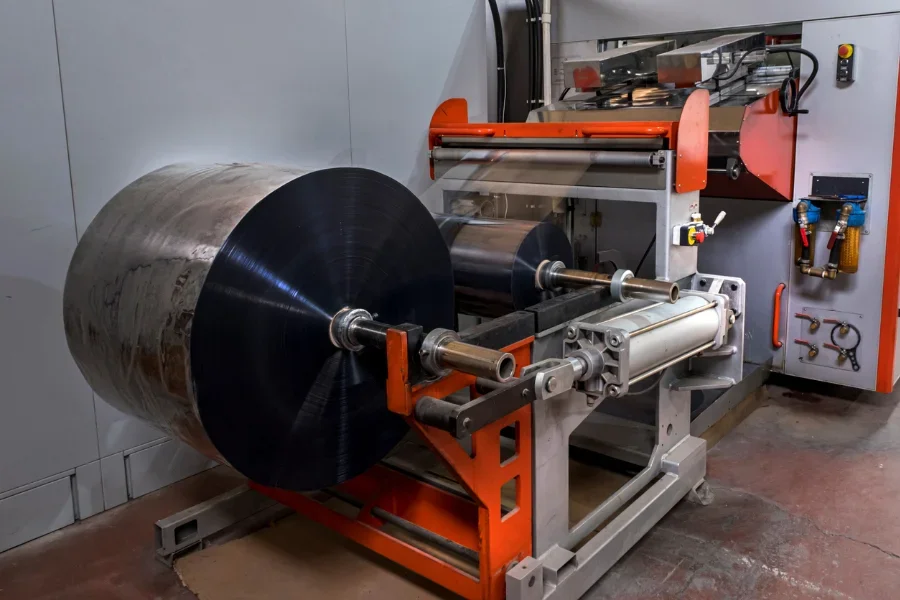Thermoforming is a process that involves heating plastic sheets until they become malleable to create a specific geometry. This plastic sheet is stretched onto a mold to create the finished form. Various thermoforming machines are available, each designed for specific applications. This article provides insights into selecting a suitable machine for your business needs.
Table of Contents
Thermoforming machines market
What to look for in plastic thermoforming machines
Applications of plastic thermoforming
Thermoforming machines market

The global thermoforming machine market was valued at USD 961 million in 2022 and is expected to grow at a CAGR of 4.3% from 2022 to 2032. The thermoforming machines market accounted for 1-2% of the global packaging machinery market in 2021, which was valued at USD 58 billion. This segment expanded due to rising demand for packaged beverages and fruit juices, among other products.
In recent years, thermoformed plastics have been used as a metal replacement in various industries, including aerospace and transportation. They also have a wide range of applications in the pharmaceutical industry.
This article provides insights into the thermoforming process, different types of thermoforming machinery, and applications.
What is plastic thermoforming?
Plastic thermoforming refers to heating small sections of plastic sheets and stretching them over a mold using a vacuum. This method is commonly used for prototype parts. However, large production machines heat and form plastic sheets and quickly trim the formed parts for high-volume applications. Depending on the machine, the size of the mold, and the parts being formed, these machines can produce thousands of finished parts per hour.
The plastic material is supplied in resin pellets or rolls, manufactured or purchased at an extrusion facility. Resin pellets are used for in-line thermoforming. The plastic sheets are fed into the thermoforming machine and transported to the heating area on chains. These chains move the sheets through the machine’s heating oven, form station, and trim station.
What are the types of plastic thermoforming?
Pressure forming and vacuum forming are the two most common types of thermoforming.
Vacuum forming: Plastic sheets are heated until they become malleable, stretched onto a mold, and formed into the desired geometry using vacuum pressure. Items such as temperature-controlled aluminum tools, epoxy, and wooden tools are used in the process. Vacuum forming is the most straightforward thermoforming technique there is.
With vacuum forming, both female and male molds can be used. When the outer dimensions are more important than the inner dimensions, female molds are used, and plastic sheets are placed inside the mold. On the other hand, male molds have thermoplastic placed over the mold and are typically used when the inside dimensions are the top priority.
Pressure forming: This is a thermoforming process in which plastic sheets are heated until they become malleable and then pressed against a mold. The air is vacuumed out of the plastic sheet, and air pressure is also applied above it. The part takes the shape of the mold once it has been cooled.
Large plastic parts can be mass-produced using pressure forming. Parts with complex shapes and tight tolerances are also easily achievable. This process allows tight corners, clean lines, and other fine details. Robotic routing is used to finish parts.
What to look for in plastic thermoforming machines

The following product specifications should be considered before selecting a thermoforming machine.
– Foaming area: It refers to the built space in which the plastic part is formed. This space has molds, core plugs, and mechanisms for imprinting patterns on preheated plastic sheets.
– Depth of draw: It refers to the draw ratio, a critical factor in the thermoforming process. This ratio enables manufacturers to determine the gauge of plastic needed for each project. It also allows manufacturers to determine the plastic part’s thickness and the surface area the plastic sheet should cover during the thermoforming process.
– Dimensions of the machine: The size of the plastic parts that can be produced is determined by the dimensions of the thermoforming machine. For instance, a desktop thermoforming machine is compact and thus has limited forming dimensions. On the other hand, industrial equipment is much larger and has a greater capacity.
– Clamping force: A few instances of thermoforming equipment, like pressure forming and matched mold forming machines, clamp down on the plastic sheet to create the finished part. The clamping force is an important factor because it determines the type of material that may be used.
– Tool change capacity: By assessing a thermoforming machine’s tool change capacity, manufacturers can determine how quickly tool changes can be carried out. A faster tool change improves efficiency, reduces costs, and increases productivity.
Types of thermoforming equipment
After determining the desired characteristics, manufacturers can choose a thermoforming machine that fits one of these categories.
Industrial thermoforming machines: These are large-scale machines designed for mass production. They are compatible with a wide range of materials and sheet thicknesses, have a higher draw, and have stronger vacuum forces to create complex details and produce high-quality outputs. Some industrial thermoforming machines are Formech, Belovac, and GN vacuum-forming machines. The prices of these machines start around USD 10,000 and go far beyond that.
Desktop thermoforming machines: These machines have smaller dimensions, exert less force, and have a limited material selection compared to industrial machines. Hobbyists and product developers typically use them to produce prototyping and custom parts in small quantities. These machines are typically priced under USD 1,000.
Types of plastics used in thermoforming

Before beginning a production cycle, it is critical to consider the physical properties of the plastic sheets to ensure compatibility. Here are some of the most commonly used thermoforming materials.
1. Polypropylene (PP): It is one of the most popular thermoforming materials in terms of volume and value. PP is used to manufacture toys, packages, and ventilators, among other products. Additionally, it has excellent resistance to chemicals, heat, and fatigue.
2. Acrylonitrile butadiene styrene (ABS): It is well-known for its rigidity, abrasion resistance, and heat resistance, which allows the plastic to be molded at high temperatures. It is used to manufacture electronic items, domestic appliances, instruments, and food containers.
3. Polyvinyl chloride (PVC): It is flexible because it can be made soft or rigid depending on the manufacturer’s needs. PVC is strong, dense, and can withstand high temperatures but is not completely chemical resistant. It is frequently used in producing window frames, pipes, electric cables, and other items.
4. Polyethylene terephthalate (PET): It has good oil and alcohol barrier properties, as well as chemical and impact resistance. It is one of the most frequently recycled plastics and is commonly used for water bottles and carbonated drinks.
5. High-density polyethylene (HDPE): It is known to have high resistance to chemicals, water, and UV rays. It has a high strength-to-density ratio and is used to manufacture water pipes, plastic bags, bottles, and packaging film.
Applications of plastic thermoforming
– Plastic thermoforming has numerous applications in various industries. It manufactures high-quality medical equipment covers that allow medical instruments to be stored clean and dry.
– Thermoforming is used to create housings for plasma, liquid crystal, and touchscreen displays.
– This process is widely used to create agricultural equipment components such as roofs and panels for tractors, sprayer shells, and livestock housings. Plastic sheets are preferred over sheet metal components because they are more resistant to UV radiation and corrosive environments.
– Plastic thermoforming is used in the automotive industry to make various car parts such as dashboards, bumpers, air ducts, doors, and floor mats.
To Sum Up
This article provided an overview of the fundamental components of plastic thermoforming machines, as well as material options and performance parameters. It also went over the most common applications and the key factors to look for when buying a thermoforming machine.



